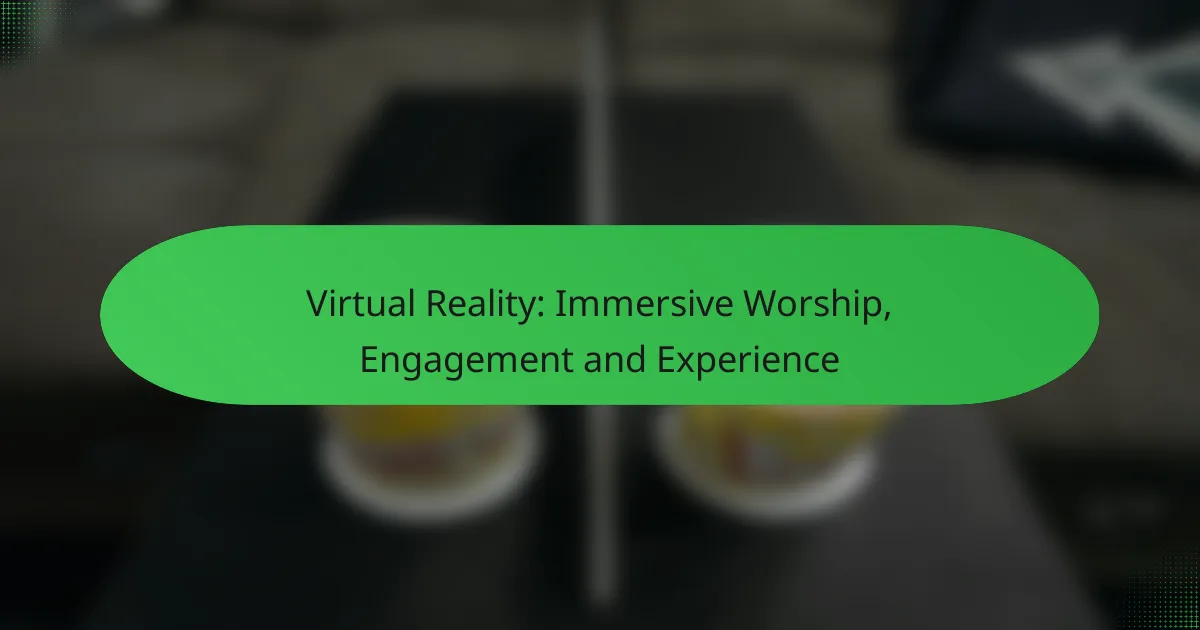Virtual reality (VR) is revolutionizing worship by providing immersive experiences that deepen spiritual engagement and foster community. Through advanced technologies, VR creates dynamic environments that allow participants to connect with their faith in innovative and accessible ways, transforming traditional practices into interactive experiences that resonate with diverse congregations.
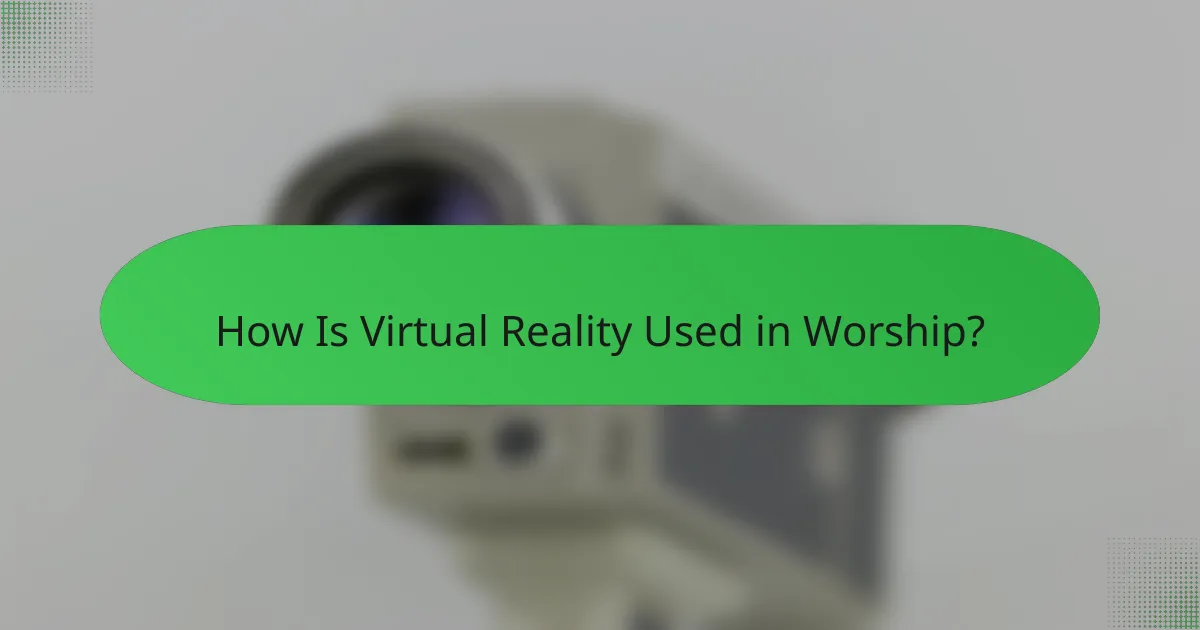
How Is Virtual Reality Used in Worship?
Virtual reality (VR) is increasingly utilized in worship settings to create immersive experiences that enhance spiritual engagement. By simulating environments and interactions, VR allows participants to connect with their faith in innovative ways, making worship more accessible and engaging.
Virtual church services
Virtual church services leverage VR technology to recreate the experience of attending a physical church. Participants can join services from anywhere, often using avatars to represent themselves in a digital congregation. This format can include live-streamed sermons, interactive prayer sessions, and communal worship activities.
Churches can reach wider audiences, including those unable to attend in person due to health or mobility issues. Many platforms offer features like chat rooms and virtual fellowship areas, fostering community even in a digital space.
Immersive prayer experiences
Immersive prayer experiences in VR allow users to engage in prayer within beautifully rendered environments, such as serene nature scenes or sacred spaces. These settings can enhance focus and provide a sense of tranquility, making prayer more impactful.
Some applications offer guided prayer sessions, where users can follow prompts or meditations while surrounded by calming visuals and sounds. This can help individuals deepen their spiritual practice and find solace in their faith.
Virtual pilgrimages
Virtual pilgrimages enable users to explore significant religious sites around the world without physical travel. Through VR, participants can visit places like Jerusalem or Mecca, experiencing the sights and sounds of these locations as if they were there.
This technology can be particularly valuable for those who cannot undertake traditional pilgrimages due to financial, physical, or logistical constraints. Virtual pilgrimages can include narrated tours, historical context, and interactive elements to enrich the experience.
Interactive scripture study
Interactive scripture study in VR allows users to engage with biblical texts in a dynamic way. Participants can explore 3D representations of biblical events or locations, enhancing their understanding of scripture through visual context.
Some platforms offer collaborative study sessions, where users can discuss interpretations and insights in real-time, fostering a sense of community and shared learning. This approach can make scripture more relatable and accessible to diverse audiences.
Community engagement platforms
Community engagement platforms in VR provide spaces for users to connect, share experiences, and participate in group activities. These platforms often include features like virtual meeting rooms, discussion forums, and event calendars, facilitating ongoing interaction among members.
Churches and religious organizations can use these platforms to host events, workshops, and social gatherings, helping to strengthen community bonds. By creating a sense of belonging, these virtual spaces can enhance the overall worship experience for participants.
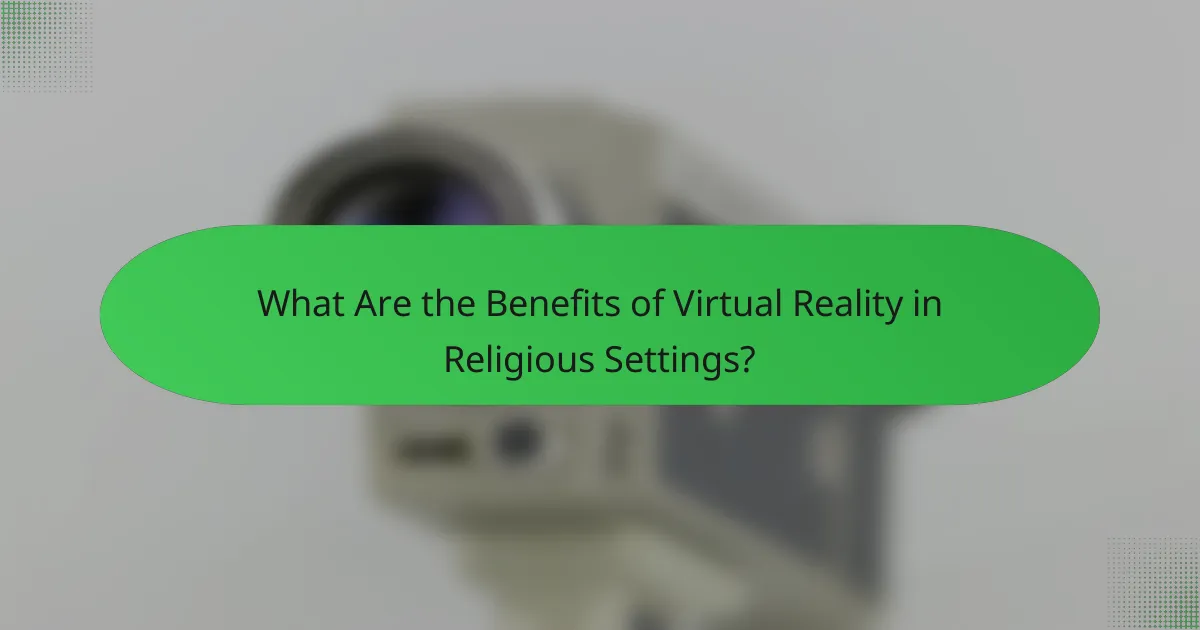
What Are the Benefits of Virtual Reality in Religious Settings?
Virtual reality (VR) in religious settings offers immersive experiences that enhance worship, foster community, and facilitate learning. By creating engaging environments, VR can transform traditional practices into dynamic interactions that appeal to diverse congregations.
Enhanced engagement
Virtual reality significantly boosts engagement by immersing worshippers in a 3D environment that stimulates the senses. This immersive experience can make religious narratives more vivid, allowing participants to feel as if they are part of the story rather than just observers.
For example, VR can recreate historical religious events or sacred spaces, enabling users to explore these settings interactively. This level of engagement can lead to deeper emotional connections and a more profound understanding of faith practices.
Accessibility for remote worshippers
VR technology breaks down geographical barriers, allowing remote worshippers to participate in services and events from anywhere in the world. This accessibility is crucial for individuals who may have mobility issues or live far from their places of worship.
By using VR, congregations can create virtual services that feel personal and inclusive, ensuring that all members, regardless of location, can engage in communal worship. This can be particularly beneficial in regions where religious gatherings are limited due to regulations or safety concerns.
Innovative teaching methods
Virtual reality introduces innovative teaching methods that can enhance religious education. Through immersive simulations, learners can explore religious texts and teachings in a more interactive way, which can lead to better retention and understanding.
For instance, VR can facilitate role-playing scenarios where participants can practice moral dilemmas or ethical decision-making based on religious principles. This hands-on approach can make learning more relatable and impactful.
Increased participation
Implementing VR in religious settings can lead to increased participation among congregants, especially younger generations who are more tech-savvy. Engaging formats can attract those who might otherwise feel disconnected from traditional worship.
To maximize participation, congregations should consider offering VR experiences that cater to various interests, such as interactive Bible studies or virtual community events. This approach can help build a sense of belonging and encourage more active involvement in religious life.
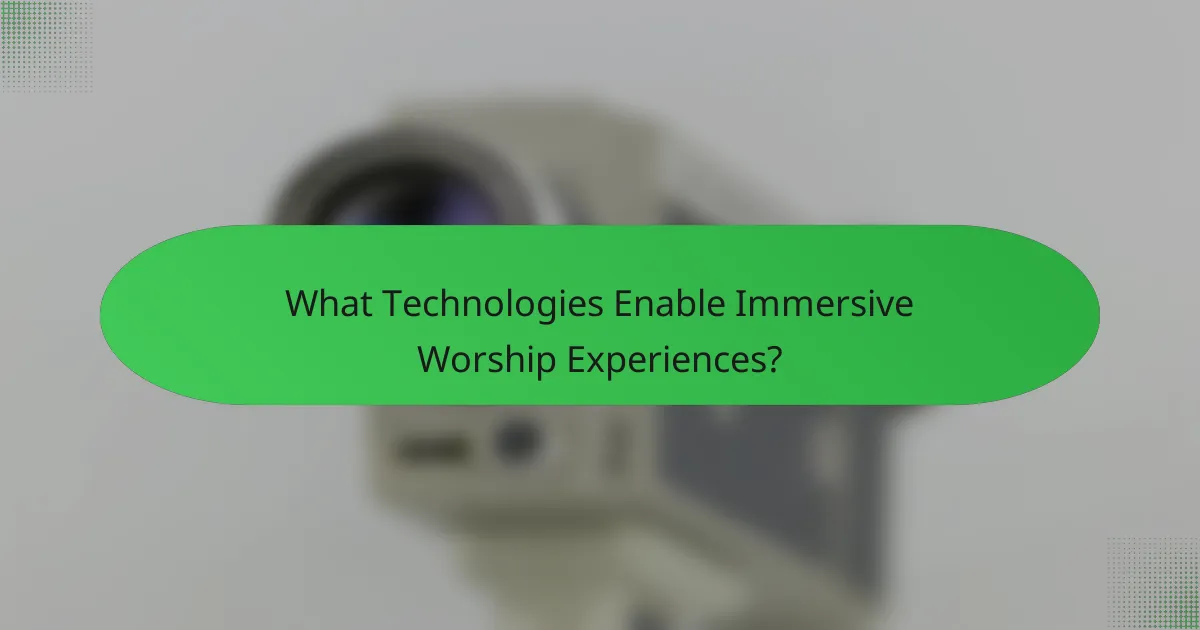
What Technologies Enable Immersive Worship Experiences?
Immersive worship experiences are primarily enabled by advanced virtual reality (VR) technologies that enhance engagement and interaction. Key technologies include VR headsets, game engines, and video platforms that create realistic environments for spiritual practices.
Oculus Quest 2
The Oculus Quest 2 is a standalone VR headset that offers a user-friendly experience without the need for external hardware. Its wireless capability allows users to move freely while engaging in immersive worship settings, making it ideal for virtual congregations or meditation sessions.
With a resolution of 1832 x 1920 per eye, the Oculus Quest 2 provides clear visuals, enhancing the realism of virtual environments. Its affordability compared to other VR systems makes it accessible for many religious organizations looking to adopt immersive technology.
HTC Vive
The HTC Vive is known for its high-quality graphics and precise motion tracking, which are crucial for creating engaging worship experiences. It requires external sensors for tracking, which can enhance spatial awareness in a virtual church setting.
This headset is often favored for its robust ecosystem of applications, allowing users to explore various religious content and experiences. However, its higher price point and setup complexity may be a consideration for smaller congregations.
Unity and Unreal Engine
Unity and Unreal Engine are powerful game development platforms that enable the creation of immersive worship environments. These engines support VR content development, allowing designers to craft detailed and interactive spiritual experiences.
Both platforms offer extensive libraries and tools for creating realistic simulations, making them suitable for developing virtual church services or meditation spaces. Familiarity with these engines can significantly enhance the quality of the immersive experience.
360-degree video platforms
360-degree video platforms allow users to experience worship services from various perspectives, providing an immersive feel without the need for complex VR setups. These platforms can be accessed via standard devices, making them widely available for congregations.
Using 360-degree videos, churches can stream services or events, allowing remote participants to feel present. This technology is particularly useful for reaching members who are unable to attend in person, expanding the community’s engagement opportunities.
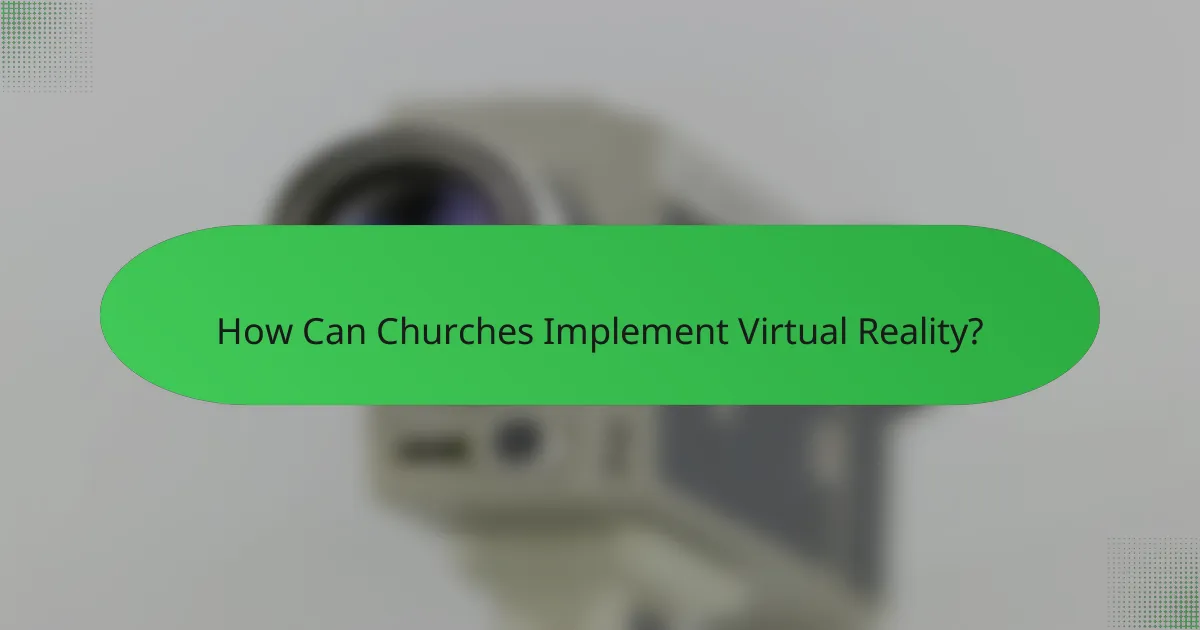
How Can Churches Implement Virtual Reality?
Churches can implement virtual reality (VR) by creating immersive environments that enhance worship experiences and engagement. This involves utilizing VR technology to foster community and connection among congregants, both in-person and remotely.
Creating virtual environments
To create virtual environments, churches should first identify the specific experiences they want to offer, such as virtual tours of sacred spaces or immersive worship services. Utilizing platforms like Oculus or HTC Vive can help in developing these environments, allowing congregants to participate in a more engaging way.
Consider collaborating with VR developers or using user-friendly software to design these spaces. Ensuring that the virtual environment reflects the church’s values and mission is crucial for maintaining authenticity.
Training volunteers
Training volunteers is essential for the successful implementation of VR in church settings. Volunteers should be familiar with the technology, including how to set up and troubleshoot VR equipment, as well as how to guide users through the virtual experience.
Offering workshops or hands-on training sessions can help volunteers gain confidence in using VR tools. It’s beneficial to create a support system where experienced volunteers can assist newcomers as they learn.
Integrating with existing services
Integrating VR with existing church services requires careful planning to ensure a seamless experience. Churches should consider how VR can complement traditional worship, such as by offering virtual attendance options for those unable to join in person.
It’s important to communicate clearly with the congregation about how VR will be used and what to expect. Regular feedback from participants can help refine the integration process and enhance overall engagement.
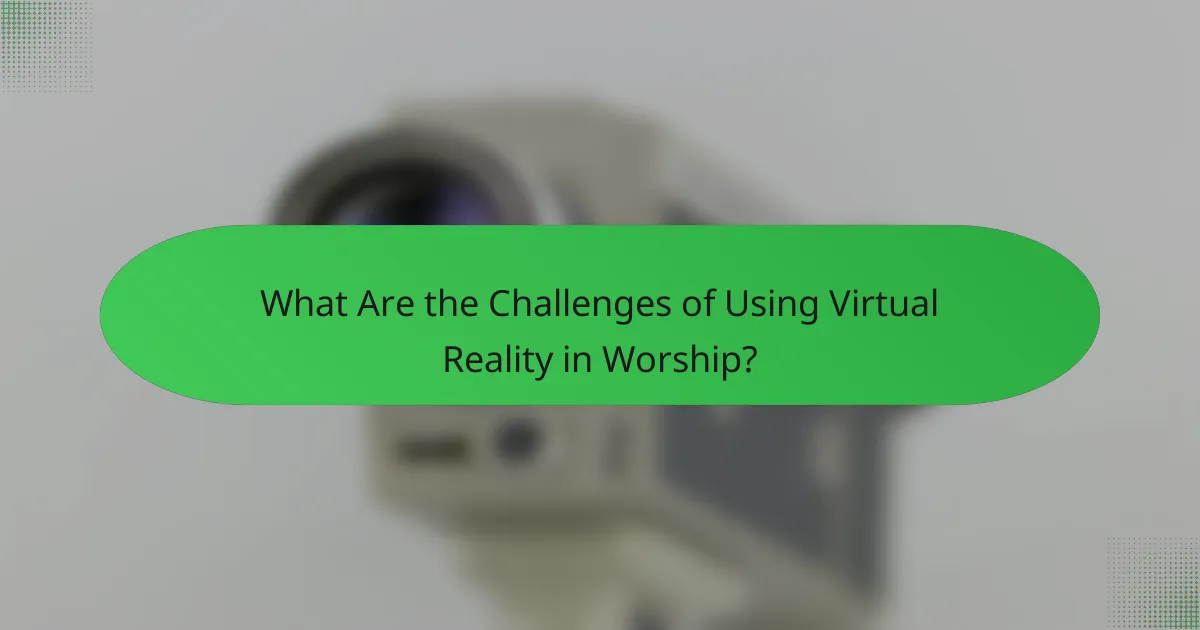
What Are the Challenges of Using Virtual Reality in Worship?
Using virtual reality (VR) in worship presents several challenges, including technical limitations, accessibility issues, and the need for meaningful content. These factors can hinder the effectiveness of VR experiences in engaging congregants and enhancing spiritual practices.
Technical Limitations
Technical limitations in VR can include hardware requirements, software compatibility, and internet connectivity. Many users may not have access to high-quality VR headsets or the necessary computing power, which can restrict participation in immersive worship experiences.
Additionally, creating engaging VR content requires specialized skills and resources. Churches may need to invest in training or hire professionals to develop effective virtual environments that resonate with their congregation.
Accessibility Issues
Accessibility is a significant challenge when implementing VR in worship. Not all congregants may be comfortable with technology, and some may have physical disabilities that make using VR equipment difficult. This can lead to feelings of exclusion among those who cannot participate fully.
To address these issues, churches should consider offering alternative formats for worship, such as live-streamed services or interactive apps, ensuring that all members can engage in spiritual practices regardless of their technological capabilities.
Content Relevance
Creating relevant and meaningful content for VR worship experiences is crucial. The virtual environment should reflect the values and beliefs of the congregation, fostering a sense of connection and community. If the content does not resonate, users may feel disengaged.
Churches should involve congregants in the content creation process, gathering feedback to ensure that the VR experiences align with their spiritual needs and preferences. This collaborative approach can enhance the overall effectiveness of VR in worship.
